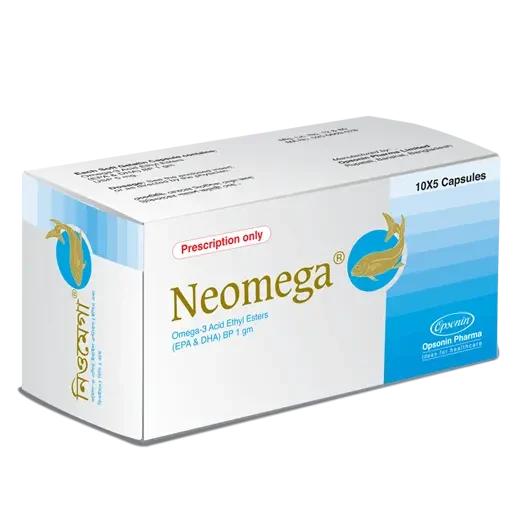Neomega Uses, Dosage, Side Effects and more
The omega-3 fatty acids eicosapentaenoic acid and docosahexaenoic acid are long-chain n-3 polyunsaturated fatty acids, which compete with arachidonic acid for inclusion in cyclo-oxygenase and lipoxygenase pathways. Their actions include hypolipidaemic action (especially a reduction in plasma triglycerides) by reducing very-low-density lipoproteins; anti-inflammatory action, attributed to effects on leukotriene synthesis; and antiplatelet effect, attributed to effects on prostanoid synthesis, which promote vasodilatation, reduction in platelet aggregation, increased bleeding time and decreased platelet counts.

| Attribute | Details |
|---|---|
| Trade Name | Neomega |
| Generic | Omega-3 Acid Ethyl Esters |
| Weight | 1000mg |
| Type | Soft Gelatin Capsule |
| Therapeutic Class | Other lipid regulating drugs |
| Manufacturer | Opsonin Pharma Ltd |
| Available Country | Bangladesh |
| Last Updated: | January 7, 2025 at 1:49 am |
Uses
Each soft gel capsule contains Omega-3-Acid Ethyl Esters 1000 mg, a combination of Eicospentaenoic acid (EPA) and Docosahexaenoic acid (DHA).
Post Myocardial Infarction: Adjuvant treatment in secondary prevention after myocardial infarction, in addition to other standard therapy (e.g. statins, anti-platelet medicinal products, beta-blockers, ACE inhibitors).
Hypertriglyceridaemia: Endogenous hypertriglyceridaemia as a supplement to diet when dietary measures alone are insufficient to produce an adequate response:
- Type IV in monotherapy
- Type IIb/III in combination with statins, when control of triglycerides is insufficient.
Dosage
Post Myocardial Infarction:One capsule daily.
Hypertriglyceridaemia:Initial treatment two capsules daily. If adequate response is not obtained, the dose may be increased to four capsules daily. The capsules may be taken with food to avoid gastrointestinal disturbances.
There is limited clinical data regarding the use of Omega-3-acid ethyl esters in elderly patients over 70 years of age and patients with renal impairment.
There is no information regarding the use of Omega-3-acid ethyl esters in children and adolescents or in patients with hepatic impairment.
How Long Does It Take to Work?
How Long Does It Take to Work? see here Neomega
Side Effects
The frequencies of adverse reactions are ranked according to the following:
- Immune system disorders: Rare- hypersensitivity;
- Metabolism and nutrition disorders: Uncommon-hyperglycaemia, gout;
- Nervous system disorders: Uncommon- dizziness, dysgeusia, headache;
- Vascular disorders: Uncommon- hypotension;
- Respiratory thoracic and mediastinal disorders: Uncommon- epistaxis;
- Gastrointestinal disorders: Common- gastrointestinal disorders (including abdominal distension, abdominal pain, constipation, diarrhoea, dyspepsia, flatulence, eructation, gastro-oesophageal reflux disease, nausea or vomiting), Uncommon- gastrointestinal haemorrhage;
- Hepatobiliary disorders: Rare- liver disorders (including transaminases increased, alanine aminotransferase increased and aspartate aminotransferase increased);
- Skin and subcutaneous tissue disorders: Uncommon- rash, Rare-urticarial.
Precaution
Because of the moderate increase in bleeding time (with the high dosage, i.e. 4 capsules), patients receiving anti-coagulant therapy must be monitored and the dosage of anti-coagulant adjusted if necessary. Use of this medication does not eliminate the need for the surveillance usually required for patients of this type. Make allowance for the increased bleeding time in patients at high risk of haemorrhage (because of severe trauma, surgery, etc). In the absence of efficacy and safety data, use of this medication in children is not recommended. During treatment with Omega-3-acid ethyl esters, there is a fall in thromboxane A2 production. No significant effect has been observed on the other coagulation factors. Some studies with omega-3-acids demonstrated a prolongation of bleeding time, but the bleeding time reported in these studies has not exceeded normal limits and did not produce clinically significant bleeding episodes. In some patients a small but significant increase (within normal values) in ASAT and ALAT was reported, but there are no data indicating an increased risk for patients with hepatic impairment. ALAT and ASAT levels should be monitored in patients with any signs of liver damage (in particular with the high dosage, i.e. 4 capsules). Omega-3-acid ethyl esters is not indicated in exogenous hypertriglyceridaemia (type 1 hyperchylomicronaemia). There is only limited experience in secondary endogenous hypertriglyceridaemia (especially uncontrolled diabetes). There is no experience regarding hypertriglyceridaemia in combination with fibrates.
Interaction
Omega-3-acid ethyl esters has been given in conjunction with warfarin without haemorrhagic complications. However, the prothrombin time must be checked when Omega-3-acid ethyl esters is combined with warfarin or when treatment with Omega-3-acid ethyl esters is stopped.
Pregnancy & Breastfeeding use
Research has confirmed that adding EPA and DHA to the diet of pregnant women has a positive effect on visual and cognitive development of the baby. Omega-3s are also used after birth to make breast milk. Studies have also shown that higher consumption of omega-3s may reduce the risk of allergies in infants.
Contraindication
Hypersensitivity to the active substance or any of the excipients.
Special Warning
Pediatric Use: Safety and effectiveness in pediatric patients have not been established.
Geriatric Use: A limited number of subjects older than 65 years were enrolled in the clinical trials of Omega-3-Acid Ethyl Esters. Safety and efficacy findings in subjects older than 60 years did not appear to differ from those of subjects younger than 60 years.
Acute Overdose
There are no special recommendations. Treatment should be symptomatic.
Storage Condition
Store in a cool and dry place, protected from light.



